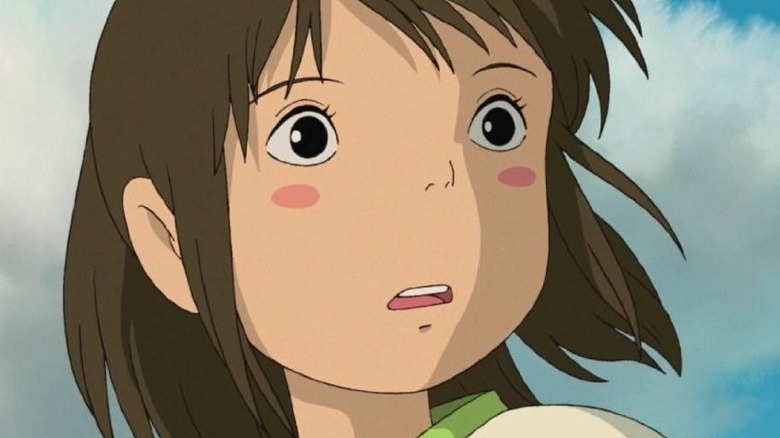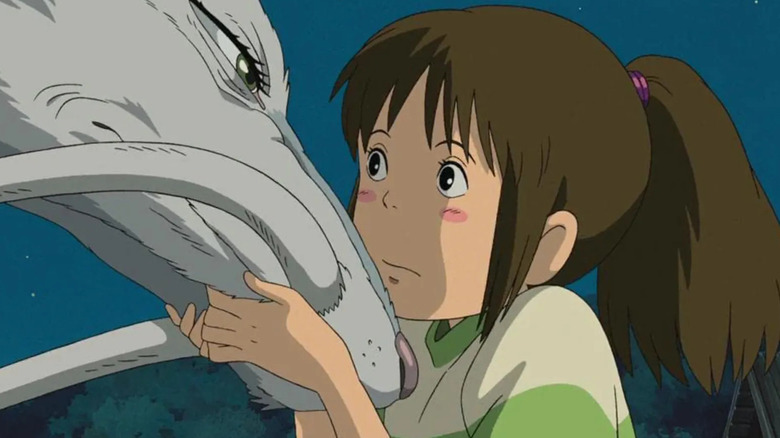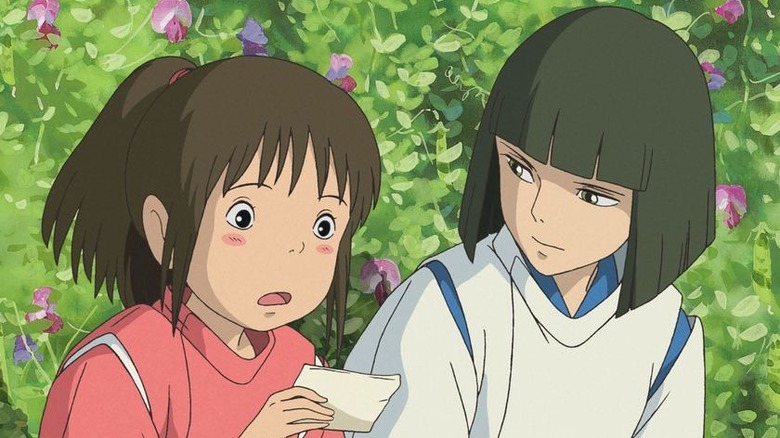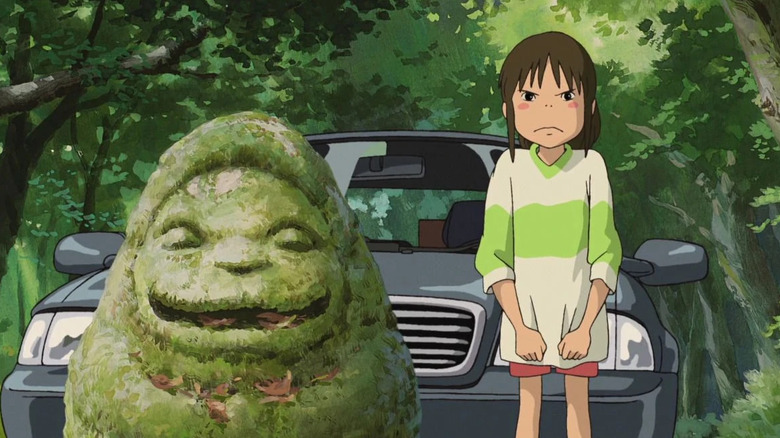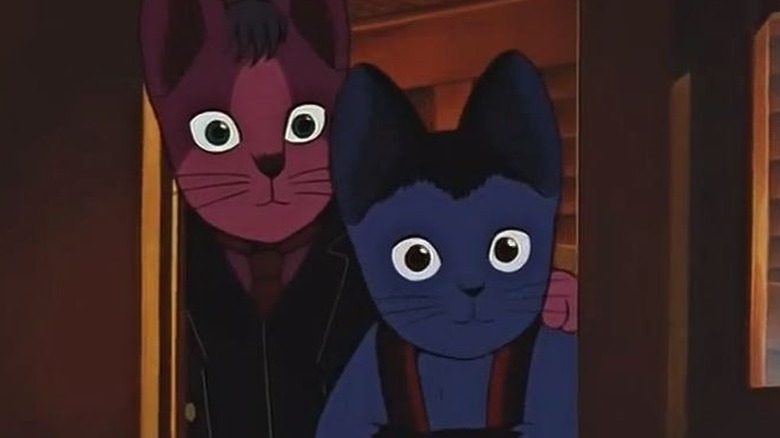The Grim Spirited Away Theory That Would Put A Dark Spin On The Film
Much like another prolific animation company, Studio Ghibli is well known for adapting older, familiar, or otherwise unique stories into beloved films. In this way, viewers were treated to "Kiki's Delivery Service" and "Howl's Moving Castle," the latter of which took a surprising amount of liberties with its source material. These two examples barely scratch the surface, too, as most of Ghibli's catalog is comprised of fantastical retellings. While not wholly singular, "Spirited Away" stands out as being a tale more inspired rather than retold.
As noted in thousands of articles (like this one from Film School Rejects), Hayao Miyazaki was inspired in part by his belief that younger audiences would still value Japanese legends and myths if they were repackaged in a fresh way. Miyazaki, it seems (in numerous interviews and articles, such as this one from Nausicaa), was also compelled by the urge to provide young girls with stories other than cheap romance plots. With these aspects in mind, he shaped the adventure of Chihiro (Daveigh Chase). Now, this is all well-trodden territory. "Spirited Away" came out in 2001, over two decades ago. What is new, however, is a theory that connects the two main characters together in a way that explains, well, just about everything. Let's take a look.
A quick Spirited Away refresher course
Before we jump into the theory, let's make sure that everyone is working with, broadly, the same information. In brief, "Spirited Away" follows Chihiro, a young girl who's swept into a world of myth after her parents are transformed into animals, a sequence that represents the dangers of consumerism. In this new place, Chihiro encounters Haku (Jason Marsden), the spirit of a young boy who knows her by name without any formal introduction. Haku — who reveals himself to be the spirit of a river in which an even younger Chihiro almost drowned in years prior — stays by her side throughout a series of trials, the likes of which include a curmudgeonly witch and a dead end janitorial position. The movie comes to a close when Chihiro rescues her parents, and the family leave, with only their young daughter carrying the memory of the surreal experience.
Obviously, there's a lot more to it than that — there's No-Face and Kamajī (David Ogden Stiers) and a swarm of devilish origami monsters. Also, Haku can metamorphose into a mighty dragon, which isn't inherently essential to the core story, but it feels important that everyone remembers. On to the theory!
Haku is Chihiro's dead, older brother
The theory, as shared on sites such as Next Shark — which is predicated by Toshio Okada (co-founder and former president of the Gainax anime production company) — suggests that Haku and Chihiro are siblings. In the third act revelation, where Haku confesses to being the spirt of the river in which Chihiro almost drowned, viewers are treated to two unique stories — a visual flashback and an explanatory monologue that doesn't quite align with what's happening on screen. Chihiro's words explain how she fell into the river while attempting to retrieve a shoe. The visuals, however, go further to show a mysterious hand reaching in to save her. While it could potentially belong to either of her parents, the sleeve on the arm is similar to what Haku wears throughout "Spirited Away." Further, the storyboard for that particular sequence specifically states, "a child's hand thrusts out suddenly."
By Okada's theory, Haku saved his sister but fell in during the process, thus becoming the spirit of the river through his sacrifice. The fact that Chihiro doesn't recall ever having a brother could be explained by how she mentions at the beginning of the river story that she doesn't even remember falling in — rather, her mother told her about it later. She could have been too young to hold on to that sort of information. Alternatively, her mother could have opted to leave out the part about her brother so that she could live without that kind of guilt weighing her down. It's also been noted that this could explain why Chihiro's mother seems unnecessarily cold towards her daughter, who she perhaps blames for the loss of her son.
Connecting even more dots
Toshio Okada's theory has even more evidence that seemingly substantiates it. Remember how Haku knew who Chihiro before she introduced herself? While it's possible for the original narrative framework to justify this as Haku remembering her from the time she stumbled into his domain, it fits snuggly within the sibling theory. Another potential element comes in the form of a conversation between Haku and Kamajī, the latter of whom refers to a form of love between Haku and Chihiro. Until now, it was presumed that the love in question was romantic, but, under this alternative skew, the love could be familial.
But we're not done yet — there's more. The instrumental theme song for "Spirited Away" is titled "Ano Hi no Kawa," which literally translates to "The River That Day." Miyazaki provided Joe Hisaishi, the composer, with lyrics to inform the sound of the piece. These lyrics tell the story of what happened on the day Chihiro almost died and allude to someone having saved her life. Consider the lines "me, who is living because of someone / someone who was living for me," which could easily be interpreted to mean that one life was traded for another.
A surprising inspiration
As if this weren't enough, Hayao Miyazaki actually admitted to a source of inspiration for "Spirited Away" that could lend credence to Haku being Chihiro's deceased brother. Kadokawa Daiei Studio's 1985 film "Night on the Galactic Railroad" inspired the magical train sequence. This is important because in "Night on the Galactic Railroad," a character not only struggles to remember their personal history but also experiences memory loss due to the fact that they're on a train taking them to the afterlife. Another layer of connection goes to show that at least one passenger of the train in "Night on the Galactic Road" drowned in their mortal life. Seeing the correlation?
There's so much evidence for this theory that it's seemingly NOT a theory but rather a legitimate facet of the story. That being said, it's not officially confirmed, but that won't keep anyone from watching a beloved Studio Ghibli film again with fresh eyes.
